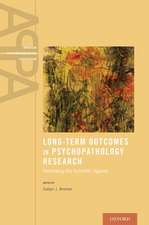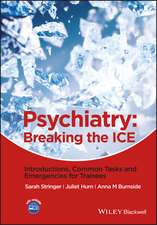Science and Football VII: The Proceedings of the Seventh World Congress on Science and Football
Editat de Hiroyuki Nunome, Barry Drust, Brian Dawsonen Limba Engleză Paperback – 23 dec 2014
- physiology of training
- performance analysis
- fitness assessment
- nutrition
- biomechanics
- injury and rehabilitation
- youth football
- environmental physiology
- psychology in football.
The papers contained within this volume were first presented at the Seventh World Congress on Science and Football, held in May 2011 in Nagoya, Japan. The meeting was held under the auspices of the International Steering Group on Science and Football, a representative member of the World Commission of Science and Sports.
| Toate formatele și edițiile | Preț | Express |
|---|---|---|
| Paperback (1) | 377.27 lei 6-8 săpt. | |
| Taylor & Francis – 23 dec 2014 | 377.27 lei 6-8 săpt. | |
| Hardback (1) | 1300.62 lei 6-8 săpt. | |
| Taylor & Francis – 16 apr 2013 | 1300.62 lei 6-8 săpt. |
Preț: 377.27 lei
Preț vechi: 397.12 lei
-5% Nou
Puncte Express: 566
Preț estimativ în valută:
72.19€ • 75.57$ • 59.73£
72.19€ • 75.57$ • 59.73£
Carte tipărită la comandă
Livrare economică 05-19 aprilie
Preluare comenzi: 021 569.72.76
Specificații
ISBN-13: 9781138837720
ISBN-10: 1138837725
Pagini: 448
Ilustrații: black & white illustrations
Dimensiuni: 156 x 234 x 23 mm
Greutate: 0.64 kg
Ediția:1
Editura: Taylor & Francis
Colecția Routledge
Locul publicării:Oxford, United Kingdom
ISBN-10: 1138837725
Pagini: 448
Ilustrații: black & white illustrations
Dimensiuni: 156 x 234 x 23 mm
Greutate: 0.64 kg
Ediția:1
Editura: Taylor & Francis
Colecția Routledge
Locul publicării:Oxford, United Kingdom
Public țintă
PostgraduateCuprins
Part I Biomechanics 1. Aerodynamic Characteristics of New Soccer Balls 2. Injury Occurrence and Footwear Performance on Artificial Soccer Turf 3. The Influence of Footwear on Ball Handling In Soccer 4. Unanticipated Compared To Preplanned Turning Movements Increase Lower Extremity Loads in Football Players 5. Cross-Sectional Change of Ball Impact in Instep Kicks from Junior to Professional Footballers 6. The Validity Of the Shadowbox™ Magnetic and Inertial Tracking System for Measuring Soccer-Specific Movements 7. Biomechanics of Punt Kicking 8. Biomechanics of Goal-Kicking In Rugby League 9. The Role of the Axial Skeleton during Rugby Union Punt Kicking 10. A Biomechanical Analysis of the Knuckling Shot in Football 11. Ideal Dive Technique in High One-Handed Soccer Saves: Top Hand Versus Bottom Hand 12. Characteristics of the Kicking Motion in Female Soccer Players Part II Exercise Physiology 13. The Physiological Effects of Soccer Training In Elite Youth Soccer Players 14. The Physiological Responses to a Laboratory-Based Soccer-Specific Training Simulation (LSSTS) On A Motorised Treadmill 15. Elite-Youth and University-Level Versions of Saft90 Simulate the Internal and External Loads of Competitive Soccer 16. Yo-Yo Intermittent Recovery Level 2 Test in Young Soccer Players from U-13 to U-18 17. The Assessment of Repeated Sprint Ability Using a Combined Sub-Maximal and Exhaustive Treadmill Protocol 18. Effect of a 2-Week Preseason Conditioning Program on Repeat Sprint Ability on Male Collegiate Soccer Athletes 19. Relationships between Isokinetic Knee Strength, Sprint and Jump Performance in Young Elite Soccer Players 20. Validity of the Yo-Yo Intermittent Recovery Test Level 1 in Assessing or Estimating Vo2max among Female Soccer Players V. 21. Physiological and Anthropometric Characteristics of Elite Women’s Rugby Union Players Part III Match Analysis 22. ‘Temporary Fatigue’ Is Not Apparent In Elite Youth Soccer Players 23. Evolution of Rule Changes and Coaching Tactics in Australian Football: Impact on Game Speed, Structure and Injury Patterns 24. Match Analysis in AFL, Soccer and Rugby Union: Patterns, Trends and Similarities 25. Spatial Strategy Used By the World Champion in South Africa’10 26. Ball Dynamics Constrain Interpersonal Coordination in Futsal 27. Score-Line Effect on Work-Rate in English Premier League Soccer 28. Addressing Opposition Quality in Rugby League Performance 29. A Method for Game Analysis Based On Dominant Region 30. Do Attacking Game Patterns Differ Between 1st And 2nd Halves Of Soccer Matches In World Championship 2010? 31. The Relationship Between (GPS) Match Activity Profile and Performance in the AFL 32. Measuring Effectiveness of Zone-Oriented Defence on Preventing Goal Scoring In Professional Soccer Matches 33. Differences between Winning, Drawing and Losing Teams in 2010 World Cup 34. Contextual Effects on the Free Kick Performance. A Case Study with a Portuguese Professional Soccer Team 35. Analysis of Finnish Young Soccer Players` Passing and Dribbling Skills Part IV Motor Behavior 36. How Skilled Gaelic Football Players Practice Kicking: Deliberate Or Not? 37. Factors Influencing Penalty Kick Success in Elite Soccer 38. Above Real Time Decision Making In Australian Football 39. Area Covered By Diving Actions Performed By Male College Soccer Goalkeepers 40. The Processes Underlying ‘Game Intelligence’ Skills in Soccer Players 41. Prior High-Intensity Intermittent Running Reduces Exercise Intensity and Skill Performance in Small-Sided Rugby Games 42. Video Self-Modeling and Kicking Accuracy On The Non-Preferred Side 43. Passing Ability of Adolescent Soccer Players during 4-Day Tournament Play Part V Performance Profiling 44. Relationship between Draft Camp Test Scores and Career Success by Position in the Australian Football League 45. Sports-Specific Anthropometry in Japanese Soccer Players Analyzed By Three-Dimensional Photonic Scanning 46. Longitudinal Changes In Sprint Performance In Relation To Fitness Development in U-14 Soccer Players 47. Anthropometrics of Elite Senior Male Italian Rugby Union Players 48. Effects of Sex, Game Format, and Skill Type on Ball Possession in Norwegian Youth Soccer 49. Adapting the Competition Model in Youth Football: A Comparison between 5-A-Side and 7-A-Side Football with U-10-Players 50. The Relationships between Change of Direction Speed, Sprint Speed and Jump Ability in Collegiate Soccer Players 51. Physical and Technical Differences between Single-Gender vs. Mixed-Gender Small-Sided Training Exercises for Elite Female Soccer Players Part VI Sports Medicine 52. A Prospective Study of Injuries Sustained During a National Rugby League Season 53. Closed-Kinetic Chain Evaluation of Ankle Joint Proprioception in Athletes with Functional Ankle Instability 54. Screening English Premier League Football Players for Exercise Induced Bronchoconstriction 55. A Novel Method to Monitor Lower Limb Muscles Flexibility in Elite Youth Soccer Players Part VII Training Science, Coaching and Psychology 56. A Case Study of Coach Practices in Skill Acquisition Training 57. The Coach-Athlete Relationship in Australian Touch Football 58. Perceptions of Effective Coaching In Australian Professional Team Sports 59. Monitoring Exercise Load and Recovery during the 2010 FIFA Soccer World Cup 60. Small-Sided Games Present an Effective Training Stimulus in Gaelic Football 61. The Effect of a Training Evaluation Tool on Youth Coaches 62. The Relevance of Sports Science Information to Coaches of Football and Rugby League 63. Coaching Practice – Turning the Camera on Yourself 64. Offensive Sequences in Youth Soccer: Experience and Small-Sided Games Effects 65. The Use of Accelerometers to Quantify the Training Load in Soccer 66. What Is The Work-Load During Training Sessions In Rugby Union? 67. Influence of Age and Fitness on Match and Training Activity Profiles in Junior Australian Football
Notă biografică
Hiroyuki (Hiro) Nunome is Associate Professor in Biomechanics at Nagoya University, Japan. He is part of the International Steering Group on Science and Football and is the Vice President of the Japanese Society of Science and Football. He is well-known as a pioneer of biomechanics in soccer, particularly of kicking, with many advanced publications in the field.
Barry Drust is Reader in Applied Exercise Physiology at Liverpool John Moores University, UK. His main research interests are focused on the physiology of intermittent exercise. As well as his academic roles he has also provided sport science support to elite Premier League football teams and national associations.
Brian Dawson is Professor of Sport/Exercise Physiology in the School of Sport Science, Exercise and Health at the University of Western Australia. He is also Chair of the International Steering Group on Science and Football. He has published around 200 papers, many concerning physiology in football codes and other team sports.
Barry Drust is Reader in Applied Exercise Physiology at Liverpool John Moores University, UK. His main research interests are focused on the physiology of intermittent exercise. As well as his academic roles he has also provided sport science support to elite Premier League football teams and national associations.
Brian Dawson is Professor of Sport/Exercise Physiology in the School of Sport Science, Exercise and Health at the University of Western Australia. He is also Chair of the International Steering Group on Science and Football. He has published around 200 papers, many concerning physiology in football codes and other team sports.
Descriere
Science and Football VII showcases the very latest scientific research into the variety of sports known as ‘football’. These include soccer, the national codes (American football, Australian rules football and Gaelic football), and the rugby codes (union and league). Bridging the gap between theory and practice, this book is by far the most comprehensive collection of current research into football, presenting important new work in key areas. Science and Football VII is an essential resource for all sport scientists, trainers, coaches, physical therapists, physicians, psychologists, educational officers and professionals working across the football codes.




















